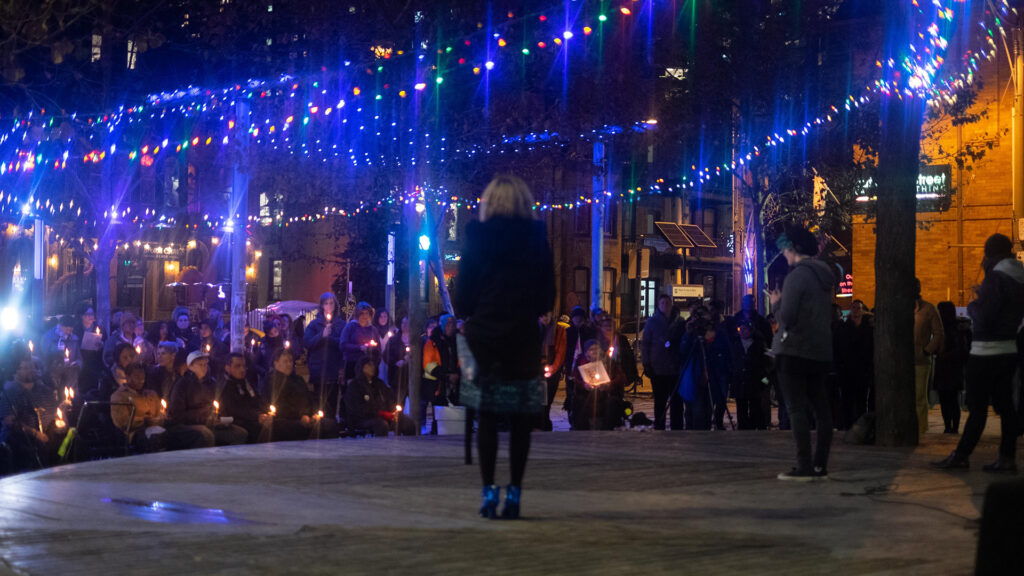Estimated reading time: 6 minutes
This blog post discusses substance use and trauma
What does mental health look like? I think that the answer probably depends. Mental health is not a one-size-fits-all concept. This question was top of mind for me when I recently spoke with community outreach workers of the Breaking the Ice (BTI) program at The 519, a city of Toronto agency dedicated to the health, happiness, and meaningful participation of 2SLGBTQ+ communities.
Breaking the Ice at the 519
Breaking The Ice (BTI) is focused on the needs and barriers faced by 2SLGBTQ+ people who use drugs in Toronto’s Downtown East. Peer-led and rooted in the principles of harm reduction and anti-violence, the team engages in regular street outreach, develops resources targeted to community needs, and supports The 519’s drop-in clients.
Nadine is a BTI coordinator, leading a team working with the people living in the encampments of Toronto. Supporting people who live outside can involve check-ins, providing basic supplies or emotional support, helping with housing or shelter, and it includes the intense work of supporting people who are in conflict with the law. It can also involve responding to people experiencing overdose.
Operating on the block in Toronto that sees one of the most overdoses in the city, harm reduction workers like Nadine are bearing witness every day to suffering and death.
“Nobody should be seeing what we see,” she says. “It’s exhausting. The grief and loss are incredibly heavy – for community, and for folks providing supports.”
Nadine’s experience provides insight into the broader conversations about a post-pandemic return to “normal.” While some sectors of society can talk about getting their lives back, many people are being left behind.
The pandemic significantly impacted the communities served by BTI and created unprecedented challenges for the people supporting them. The crisis shifted everything about their work. The need for housing and shelter was already at a crisis level before the pandemic, but COVID-19 exacerbated the situation. There was a lack of trauma-informed services available and widespread disruptions to health and social service offerings, and minimal access to wrap-around supports. Despite the challenges, The 519 never stopped service provision, and pivoted to an essential service provision model.

Opioid deaths and hospitalizations surged significantly across Ontario after the pandemic hit in early 2020, seriously impacting people who were under or unemployed, precariously housed, or unhoused. In 2021, 2,819 people died from opioid toxicity, an increase from 2,460 opioid deaths the year before, according to data from the Office of the Chief Coroner. These statistics, the BTI team points out, need to be framed with the understanding that many overdoses go unreported.
Nadine and her colleagues worry about the future. They see increasing poverty, evictions, lost employment, worsening affordability, and discrimination affecting more people. Youth are part of the upward trend. In a given year, there are at least 35,000-40,000 youth in Canada who are unhoused or precariously housed, staying with friends, living in “squats,” renting rooms in boarding houses, or are street-involved. Unhoused youth report high rates of alcohol and substance use compared to youth in the general population and are disproportionately exposed to violence with limited access to healthcare.
Indigenous youth and African, Caribbean, and Black youth are over-represented in the numbers of youth affected. Youth who identify as 2SLGBTQ+ make up 25-40% of the youth experiencing homelessness. Trans youth often face unique and complex challenges. As well as discrimination in the shelter system trans youth often face mistreatment and violence. Nadine and the BTI team often witness their communities having to navigate systemic discrimination within shelter environments.
Wellness As Privilege
The statistics and numbers provide context but cannot illustrate what it’s like to try to survive in subsistence mode where access to basics such as water and sanitation is not necessarily a given. As Nadine and her colleagues point out, looking at the situation from a distance with an arms-length perspective, is a position of privilege. “How can we even ask about their wellness and mental health,” says Nadine, “when people are struggling to get their basic needs met? It’s unfair.”
It’s an important question as policy makers grapple with the uneven effects of the pandemic. How can we put physical and mental health on equal footing without addressing systemic barriers and questions of access?
The pandemic has magnified deep social problems that pre-existed it, holding up a mirror to our failings as a society. In April, New York Times op-ed page editor Sarah Wildman underscored this point: “Society has rarely taken the most vulnerable into account when it comes to how daily life is navigated. The irony is, if we made vulnerability less stigmatized, less isolated, less shameful, and invisible… we might be less afraid of it.”
To the people like Nadine who do this work, the fundamental issue of basic human rights is eclipsed by the anti-poverty rhetoric and the invisibility of the substance use crisis in Canada. Yet the pandemic has added another layer of complexity. “The pandemic has been overshadowing this equally important public health crisis, the overdose situation is not being talked about. There is no appetite to hear about it.” The shame and the stigma associated with substance use is divided between socially acceptable and criminal substances. “All social classes use drugs. Find someone who has not been touched by it.” says Nadine.
Showing Up in Meaningful Ways
The 519’s BTI program is based on relationships and consent-based interactions. Supporting people with respect and dignity is based on workers like Nadine being available when and how they are needed and meeting people where they are. “If someone needs five hours of my time, that’s ok”, Nadine says, “but it is challenging in such a high-needs context”.
Doing this work often means reframing our notions of success. For example, when Nadine assisted a client who was experiencing a serious mental health crisis, she assisted the person in getting “formed” – meaning they were voluntarily admitted to a psychiatric facility as an alternative to being incarcerated. (The term “formed” comes from the Form 1 psychiatric assessment that a physician completes to determine if a person needs to be admitted for further care as an involuntary or voluntary patient). In this case, the person was able to access treatment rather than being immediately jailed—meaning they were treated as a person who needed care rather than as a criminal.
Nadine and workers like her see firsthand the effects of stigma and the hyper-criminalization of communities of people who live outside and/or use substances and the attendant cycles of homelessness and incarceration.
Placing human dignity at the centre
According to a growing body of research, a shortage of affordable housing directly contributes to homelessness but so do systems failures that include difficult transitions from child welfare, and inadequate discharge planning for people leaving hospitals, corrections and mental health and substance use treatment facilities.
The common threads of systems failures, stigma, and discrimination seem inextricably intertwined, like a gordian knot. For policy makers attempting to untangle that knot, one thing becomes clear: what is needed is an approach that is rooted in human rights and addresses historic harms, colonialism, and institutional oppression. An approach that is informed by human dignity, rather than perceptions from a perspective of privilege.
When asked how she copes with working on the front lines of the crisis, Nadine says that despite the heavy toll of this work on her own mental health, “knowing what happens is disturbing but not more disturbing than not being there.”
Views and opinions expressed in this blog post belong solely to the original author and do not necessarily represent the views and opinions of the Mental Health Commission of Canada.





